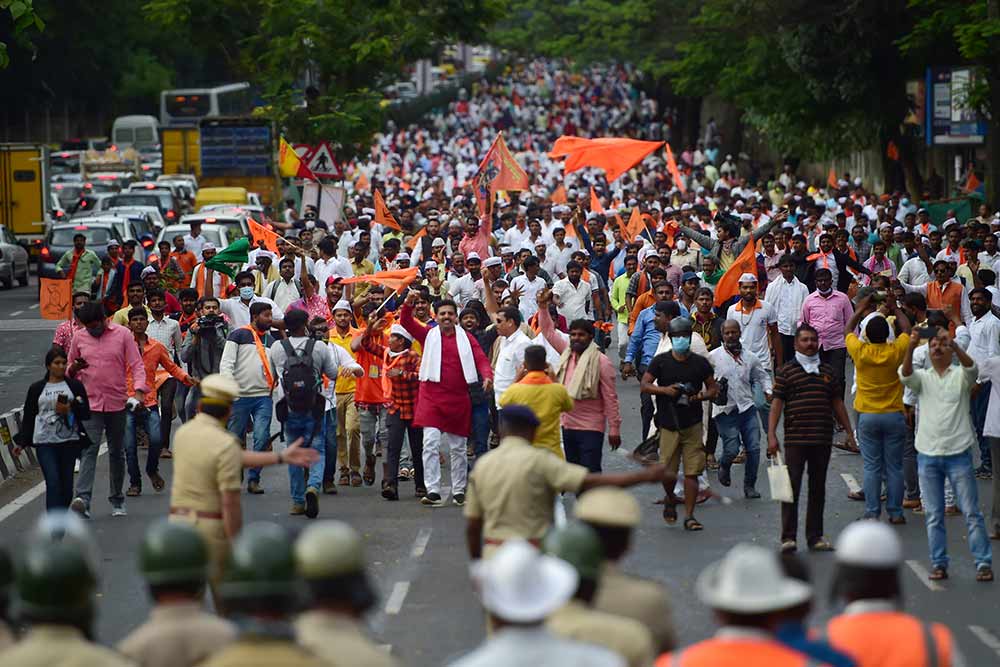
Breaking into Karnataka's power circuits, ‘mathadishas’ wield de facto authority

Swami Pranavananda, the ‘mathadisha’ or ‘muttadishas’ (head priest) of the Idiga mutt had already breached the norms of sainthood when he enthusiastically and publicly gave up celibacy and embraced ‘grihasta’ status by getting married in 2016.
The previous year, Pranavananda had been questioned in connection with the murder of M M Kalaburgi, a rationalist. In that year, he also ironically gave the Hindu Mahasabha, of which he was the chief, a chance to be ‘saintlier’, when he was expelled from that organization, ostensibly on grounds, among others, that he had fanned communal disharmony! So this Swami (seer), who had made an unsuccessful bid to convert his ‘saintly capital’ into political coin by standing for elections, was perhaps once more testing the waters for a direct entry into politics, when he announced recently that he ‘would be present at the oath-taking ceremony of the next chief minister’, who, he predicted, would be from the Arya Idiga Samaja.
The seer has now joined the large and growing pantheon of men in saffron who have been swarming the streets of Karnataka since January this year, seeking enhanced reservation status for their castes/sub-castes. As head of the Sharana Basaveshwara Mutt in Haveri, he has demanded scheduled caste (SC) status for the Idiga community, ranked fourth in terms of population after the Lingayats, Vokkaligas and Kurubas, and currently included in the 2A (or more backward) category, which already enjoys 15% reservation. He does all this, while publicly avowing allegiance to the revolutionary legacies of Sree Narayana Guru’s philosophy. Pranavananda, however, has a slight difference of opinion. ‘Without caste, we cannot do anything,’ he publicly says.
For long, as wielders of de facto power in Karnataka’s villages, ‘muttadishas’ of the state have exerted control over politicians, even shaping their destinies. Former chief minister Nijalingappa testified to this power in his autobiography. Particularly Lingayat seers, who command an estimated 4,000 mutts in the state, have been acknowledged, and even praised, for their close association with ‘development’ activities of villages and towns where they are located. None, however, has thus far taken that short step to emulating the redoubtable Ajay Bisht aka Yogi Adityanath (Uttar Pradesh CM), in their quest to formally break into the circuit of political power.
Also read: Under Modi, Hindutva has gained primacy of place over development
The fact is that they did not need to, since they enjoyed, and continue to enjoy, a moral authority that no elected representative in contemporary Karnataka can afford to ignore. There is the formidable scholarly reputation of the Taralabalu Swami and his popular arbitration efforts via the Nyaya Peetha (a weekly court over which he presides to settle local disputes). The seer of the Chitradurga Mutt famously pioneered a radical social justice agenda by endowing smaller sub-castes with the land and the resources to start their own mutts. The Sanehalli Swami hosts a celebrated annual theatre festival. There was the fierce anti-communalist stance of the Nidamamudi mutt swami, and the empire of educational institutions run by the Suttu, Siddaganga, and many others. No wonder they have been called the ‘unauthorised government’ of Karnataka.
The visit to the powerful mutts is almost obligatory on the part of aspiring and incumbent politicians. But of late, the smaller mutts too are laying claims to government resources and support.
In addition to asking for changes in reservation categories/percentages, like many before him, Pranavananda Swami has been demanding a ‘development authority’ or corporation to serve the Idigas. Had COVID not intervened to put an end to public demonstrations, one might even have called what was unfolding ‘a war of all against all’.
Does this fragmentation of caste solidarities and the intensifying ‘fight for backwardness’ by castes/sub-castes at all threaten or dislodge the terrifying unity of Hindutva? The ambitions of figures like Swami Pranavananda are not reassuring. The unity project, moreover, continues on other registers. On January 6, 2021, full-page ads in both the Kannada and English press – featuring the PM and the CM — announced the ‘groundbreaking ceremony for the construction of a new ‘Anubhava Mantapa’ at Basavakalyan. The historic location of the 12th-century revolution of the Sharanas – and the splendid literary culture that it spawned – has now been annexed to the project of uniting all Hindus under the banner of an enlightened religious order, for which the term ‘sanatana’ was yoked to ‘pragathipara’ (or progressive). The PM did his bit to claim the ‘anubhava mantapa’ as another ‘historic’ first: even the Magna Carta (1215) came only after this ‘earliest example of a people’s legislative forum.’
Also watch: Decoding: ‘The Republic Of Hindutva’
Politicians, litterateurs, and even some muttadishas immediately objected to this blatant subversion of the ideals of Basava, the 12th-century mystic and reformer who questioned, as did his followers, the tenets of Hinduism. The critics argued that the terms ‘pragatipara’ and ‘sanatana’ were a contradiction in terms, and certainly did not reflect what the sharanas had stood for. Basava tattva’s anti-casteness has now morphed into an immersion in casteness.
The paradox between the insistence on (Hindutva) unity and the raucous call to competitive separateness may yet be the only grotesque hope in these confusing times. As the ‘progressive’ aspects of the Karnataka mutt’s secular engagements cede space to the cacophonous sectarian demands for recognition and political power, they, temporarily at least, check the surge towards unity on questions of cow protection, population registers and the like.
*Janaki Nair is a retired Professor of History, Centre for Historical Studies, JNU, Delhi. She now lives and teaches in Bengaluru. Her books include The Promise of the Metropolis; Bangalore’s Twentieth Century (2005) and Mysore Modern; Rethinking the Region under Princely Rule (2011).


